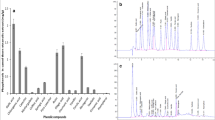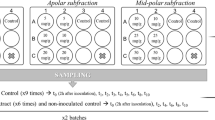Abstract
Foodborne pathogens cause foodborne diseases and pose a major food safety challenge to the food industry. The aim of this study was to evaluate the antimicrobial activity of Laminaria japonica extract against foodborne pathogens, to optimize the extraction of antimicrobial substance, and to investigate the antimicrobial mechanism. L. japonica ethanol extract exhibited significant (P < 0.05) antimicrobial activities against Staphylococcus aureus, Bacillus subtilis, Escherichia coli, Proteus vulgaris, Enterobacter aerogenes and Candida tropicalis. The minimum inhibitory concentration (MIC) values ranged from 0.26 ± 0.10 to 1.67 ± 0.72 mg/mL. Based on the results of antimicrobial activity assay and MIC test, E. coli was used as the represented pathogen to optimize extraction conditions, and to perform the bio-guided assay and investigate the antimicrobial mechanism. An L27(313) orthogonal array design was employed to obtain high levels of antimicrobial substance production. The optimum conditions were extraction temperature 80 °C, extraction time 4 h, and ratio of solid to liquid 1:10 (g/mL). The bio-guided assay showed that dichloromethane fraction from L. japonica ethanol extract (DFL) exhibited the strongest (P < 0.05) antimicrobial activity. The major compounds of DFL were palmitic acid (42.55%), oleic acid (17.40%), and myristic acid (17.31%). Treatment with DFL caused obvious morphological and ultrastructural changes, cytomembrane disruption, membrane depolarization, accumulation of reactive oxygen species (ROS), inhibition of ATPase activity, reduction of DNA content, and subsequently destruction of the cell cycle. Our findings demonstrate that the cell membrane is a primary target of DFL action on E. coli and L. japonica ethanol extract has promising potential as a natural food preservative.





Similar content being viewed by others
References
Y.B. Zhang, X.Y. Liu, Y.F. Wang, P.P. Jiang, S.Y. Quek, Antibacterial activity and mechanism of cinnamon essential oil against Escherichia coli and Staphylococcus aureus. Food Control 59, 282–289 (2016). https://doi.org/10.1016/j.foodcont.2015.05.032
J. Tian, X.B. Zeng, Z.Z. Feng, X.M. Miao, X. Peng, Y.W. Wang, Zanthoxylum molle Rehd. Essential oil as a potential natural preservative in management of Aspergillus flavus. Ind. Crop. Prod. 60, 151–159 (2014). https://doi.org/10.1016/j.indcrop.2014.05.045
M.E. Fleming-Jones, R.E. Smith, Volatile organic compounds in foods: a five year study. J. Agric. Food Chem. 51, 8120–8127 (2003). https://doi.org/10.1021/jf0303159
V.C.H. Wu, X.J. Qiu, A. Bushway, L. Harper, Antibacterial effects of American cranberry (Vaccinium macrocarpon) concentrate on foodborne pathogens. LWT-Food Sci. Technol. 41, 1834–1841 (2008). https://doi.org/10.1016/j.lwt.2008.01.001
P. Goñi, P. López, C. Sánchez, R. Gómez-Lus, R. Becerríl, C. Nerín, Antimicrobial activity in the vapour phase of a combination of cinnamon and clove essential oils. Food Chem. 116, 982–989 (2009). https://doi.org/10.1016/j.foodchem.2009.03.058
Q. Shang, X. Shan, C. Cai, J. Hao, G. Li, G. Yu, Dietary fucoidan modulates the gut microbiota in mice by increasing the abundance of Lactobacillus and Ruminococcaceae. Food Funct. 7, 3224–3232 (2016). https://doi.org/10.1039/C6FO00309E
Z. Liu, X. Li, W. Xie, H. Deng, Extraction, isolation and characterization of nanocrystalline cellulose from industrial kelp (Laminaria japonica) waste. Carbohydr. Polym. 173, 353–359 (2017). https://doi.org/10.1016/j.carbpol.2017.05.079
Y. Sun, S. Hou, S. Song, B. Zhang, C. Ai, X. Chen, N. Lin, Impact of acidic, water and alkaline extraction on structural features, antioxidant activities of Laminaria japonica polysaccharides. Int. J. Biol. Macromol. 112, 985–995 (2018). https://doi.org/10.1016/j.ijbiomac.2018.02.066
J.K. Patra, G. Das, K.H. Baek, Chemical composition and antioxidant and antibacterial activities of an essential oil extracted from an edible seaweed Laminaria japonica L. Molecules 20, 12093–12113 (2015). https://doi.org/10.3390/molecules200712093
D. Kuhn, R. Ziem, T. Scheibel, B. Buhl, G. Vettorello, L.A. Pacheco, D. Heidrich, C. Kauffmann, E.M. de Freitas, E.M. Ethur, L. Hoehne, Antibiofilm activity of the essential oil of Campomanesia aurea O. Berg against microorganisms causing food borne diseases. LWT-Food Sci. Technol. 108, 247–252 (2019). https://doi.org/10.1016/j.lwt.2019.03.079
N.A. Al-Shabib, F.M. Husain, I. Ahmad, M.S. Khan, R.A. Khan, J.M. Khan, Rutin inhibits mono and multi-species biofilm formation by foodborne drug resistant Escherichia coli and Staphylococcus aureus. Food Control 79, 325–332 (2017). https://doi.org/10.1016/j.foodcont.2017.03.004
Y. Cortés, E. Hormazábal, H. Leal, A. Urzúa, A. Mutis, L. Parra, A. Quiroz, Novel antimicrobial activity of a dichloromethane extract obtained from red seaweed Ceramium rubrum (Hudson) (Rhodophyta: Florideophyceae) against Yersinia ruckeri and Saprolegnia parasitica, agents that cause diseases in salmonids. Electron. J. Biotechnol. 17, 126–131 (2014). https://doi.org/10.1016/j.ejbt.2014.04.005
H. Omar, A. Al-Judaibiand, A. El-Gendy, Antimicrobial, antioxidant, anticancer activity and phytochemical analysis of the red alga Laurencia papillosa. Int. J. Pharmacol. 14, 572–583 (2018). https://doi.org/10.3923/ijp.2018.572.583
Y. Wang, Q. Zhang, C.L. Zhang, P. Li, Characterisation and cooperative antimicrobial properties of chitosan/nano-ZnO composite nanofibrous membranes. Food Chem. 132, 419–427 (2012). https://doi.org/10.1016/j.foodchem.2011.11.015
H.Y. Cui, C.H. Zhang, C.Z. Li, L. Lin, Antimicrobial mechanism of clove oil on Listeria monocytogenes. Food Control 94, 140–146 (2018). https://doi.org/10.1016/j.foodcont.2018.07.007
T. Dikpınar, S. Süzgeç-Selçuk, B.Ö. Çelik, E.A. Uruşak, Antimicrobial activity of rhizomes of Ferulago trachycarpa Boiss. and bioguided isolation of active coumarin constituents. Ind. Crop Prod. 123, 762–767 (2018). https://doi.org/10.1016/j.indcrop.2018.06.072
M.F.B. Vázquez, L.R. Comini, R.E. Martini, S.C.N. Montoya, S. Bottini, J.L. Cabrera, Ultrasonic-assisted extraction of anthraquinones from Heterophyllaea pustulata Hook f. (Rubiaceae) using ethanol-water mixtures. Ind. Crop Prod. 69, 278–283 (2015). https://doi.org/10.1016/j.indcrop.2015.01.065
S. Tajbakhsh, M. Ilkhani, A. Rustaiyan, K. Larijani, K. Sartavi, R. Tahmasebi, G. Asayesh, Antibacterial effect of the brown alga Cystoseira trinodis. J. Med. Plants Res. 5, 4654–4657 (2011)
K.H. Kim, D. Yu, S.H. Eom, H.J. Kim, D.H. Kim, H.S. Song, D.M. Kim, Y.M. Kim, Fucofuroeckol-A from edible marine alga Eisenia bicyclis to restore antifungal activity of fluconazole against fluconazole-resistant Candida albicans. J. Appl. Phycol. 30, 605–609 (2018). https://doi.org/10.1007/s10811-017-1232-1
A.P. Baliano, E.F. Pimentel, A.R. Buzin, T.Z. Vieira, W. Romão, L.V. Tose, D. Lenz, T.U. de Andrade, M. Fronza, T.P. Kondratyuk, D.C. Endringer, Brown seaweed Padina gymnospora is a prominent natural wound-care product. Rev. Bras. Farmacogn. 26, 714–719 (2016). https://doi.org/10.1016/j.bjp.2016.07.003
L. Shi, F. Ren, X. Zhao, Y. Du, F. Han, Supercritical carbon dioxide extraction of Microula sikkimensis seed oil. J. Am. Oil Chem. Soc. 87, 1221–1226 (2010). https://doi.org/10.1007/s11746-010-1602-1
H.L. Alakomi, E. Skyttä, M. Saarela, T. Mattila-Sandholm, K. Latva-Kala, I.M. Helander, Lactic acid permeabilizes gram-negative bacteria by disrupting the outer membrane. Appl. Environ. Microb. 66, 2001–2005 (2000). https://doi.org/10.1128/AEM.66.5.2001-2005.2000
J. Zhang, Z.G. Tian, J.H. Wang, A.R. Wang, Advance in antimicrobial molecular mechanism of organic acids. Acta Vet. Zootechn. Sin. 42, 323–328 (2011)
C.B. Huang, Y. Alimova, T.M. Myers, J.L. Ebersole, Short-and medium-chain fatty acids exhibit antimicrobial activity for oral microorganisms. Arch. Oral Biol. 56, 650–654 (2011). https://doi.org/10.1016/j.archoralbio.2011.01.011
C. Altieri, A. Bevilacqua, D. Cardillo, M. Sinigaglia, Antifungal activity of fatty acids and their monoglycerides against Fusarium spp. in a laboratory medium. Int. J. Food Sci. Technol. 44, 242–245 (2009). https://doi.org/10.1111/j.1365-2621.2007.01639.x
G. Singh, S. Maurya, M.P. de Lampasona, C.A.N. Catalan, Studies on essential oils, Part 41. Chemical composition, antifungal, antioxidant and sprout suppressant activities of coriander (Coriandrum sativum) essential oil and its oleoresin. Flavour Fragr. J. 21, 472–479 (2006). https://doi.org/10.1002/ffj.1608
T. Rosemary, A. Arulkumar, S. Paramasivam, A. Mondragon-Portocarrero, J.M. Miranda, Biochemical, micronutrient and physicochemical properties of the dried red seaweeds Gracilaria edulis and Gracilaria corticata. Molecules 24, 2225 (2019). https://doi.org/10.3390/molecules24122225
L. Mateus-Reguengo, L. Barbosa-Pereira, W. Rembangouet, M. Bertolino, M. Giordano, O. Rojo-Poveda, G. Zeppa, Food applications of Irvingia gabonensis (Aubry-Lecomte ex O’Rorke) Baill., the ‘bush mango’: a review. Crit. Rev. Food Sci. 1–14 (2019). https://doi.org/10.1080/10408398.2019.1646704
S. Petropoulos, Â. Fernandes, C. Pereira, N. Tzortzakis, J. Vaz, M. Soković, L. Barros, I.C.F.R. Ferreira, Bioactivities, chemical composition and nutritional value of Cynara cardunculus L. seeds. Food Chem. 289, 404–412 (2019). https://doi.org/10.1016/j.foodchem.2019.03.066
L. Jia, X.L. He, N.G. Tao, H.E. Zhou, Inhibitory effect of Ponkan essential oils at different ripening stage on P. italicum and P. digitatum. Sci. Technol. Food Ind. 34, 67–76 (2013)
L.I. Oliveira de Souza, P.C. Bezzera-Silva, D.M. do Amaral Ferraz Navarro, A.G. de Silva, M.T. Dos Santos Correia, M.V. da Silva, R.C.B.Q. de Figueiredo, The chemical composition and trypanocidal activity of volatile oils from Brazilian Caatinga plants. Biomed. Pharmacother. 96, 1055–1064 (2017). https://doi.org/10.1016/j.biopha.2017.11.121
C.Q. Wang, S.J. Pan, G.f. Zuo, Z.B. Wang, Y. Luo, GC-MS analysis of chemical composition and antibacterial activity of volatile oil from flowers of Elaeagnus lanceolata Warb. apud Diels. Food Sci. 34, 191–193 (2013)
Y.B. Kang, H.S. Shang, Y.M. Cheng, Inhibition activities of paeonol to plant pathogenic fungi in vitro. Acta Phytophylacica Sinica 34, 580–584 (2007)
Y. Peng, W.N. Cai, S.H. Xiao, H.X. Chen, Study on composition, antioxidant and antibacterial activities of Vetiveria zizanioides oil. Food Ind. 38, 167–170 (2017)
Y.Z. Wang, H. Luo, S.X. Zhao, Analysis of chemical components in volatile oil and the antibacterial activity of extracts from flower of Albizzia julibrissin. Hubei Agric. Sci. 51, 1245–1247 (2012)
J.J. Kabara, Antimicrobial agents derived from fatty acids. J. Am. Oil Chem. Soc. 61, 397–403 (1984). https://doi.org/10.1007/BF02678802
G.B. Deng, X.L. Zhang, Y.Y. Wang, Y. Lin, X.L. Chen, Chemical composition and antimicrobial activity of the essential oil of Iris pallida Lam. Chem. Ind. Forest Prod. 28, 39–44 (2008)
S.A. Alrumman, In vitro antimicrobial activity and GC-MS findings of the gel of Aloe vacillans forssk. of Abha region, Saudi Arabia. Arab. J. Sci. Eng. 43, 155–162 (2018). https://doi.org/10.1007/s13369-017-2785-7
E. Witkowska-Banaszczak, J. Dlugaszewska, Essential oils and hydrophilic extracts from the leaves and flowers of Succisa pratensis Moench. and their biological activity. J. Pharm. Pharmacol. 69, 1531–1539 (2017). https://doi.org/10.1111/jphp.12784
X. Deng, S.Z. Tang, Q. Wu, J. Tian, W.W. Riley, Z.Q. Chen, Inactivation of Vibrio parahaemolyticus by antimicrobial photodynamic technology using methylene blue. J. Sci. Food Agric. 96, 1601–1608 (2016). https://doi.org/10.1002/jsfa.7261
B. Ibrahim, A. Sowemimo, L. Spies, T. Koekomoer, M. van de Venter, O.A. Odukoya, Antiproliferative and apoptosis inducing activity of Markhamia tomentosa leaf extract on HeLa cells. J. Ethnopharmacol. 149, 745–749 (2013). https://doi.org/10.1016/j.jep.2013.07.040
J.M. Kang, L. Liu, X.X. Wu, Y.Y. Sun, Z.F. Liu, Effect of thyme essential oil against Bacillus cereus planktonic growth and biofilm formation. Appl. Microbiol. Biotechnol. 102, 10209–10218 (2018). https://doi.org/10.1007/s00253-018-9401-y
P. Fei, M.A. Ali, S.Y. Gong, Q. Sun, X. Bi, S.F. Liu, L. Guo, Antimicrobial activity and mechanism of action of olive oil polyphenols extract against Cronobacter sakazakii. Food Control 94, 289–294 (2018). https://doi.org/10.1016/j.foodcont.2018.07.022
M. Díaz, M. Herrero, L.A. García, C. Quiros, Application of flow cytometry to industrial microbial bioprocesses. Biochem. Eng. J. 48, 385–407 (2010). https://doi.org/10.1016/j.bej.2009.07.013
A. Sharma, S. Srivastava, Anti-Candida activity of two-peptide bacteriocins, plantaricins (Pln E/F and J/K) and their mode of action. Fungal. Biol. 118, 264–275 (2014). https://doi.org/10.1016/j.funbio.2013.12.006
K.R. Wang, W. Dang, J.Q. Xie, R.R. Zhu, M.Y. Sun, F.J. Jia, Y.Y. Zhao, X.P. An, S. Qiu, X.Y. Li, Z.L. Ma, W.J. Yan, R. Wang, Antimicrobial peptide protonectin disturbs the membrane integrity and induces ROS production in yeast cells. BBA Biomembranes 1848, 2365–2373 (2015). https://doi.org/10.1016/j.bbamem.2015.07.008
I.K. Maurya, S. Pathak, M. Sharma, H. Sanwal, P. Chaudhary, S. Tupe, M. Deshpande, V.S. Chauhan, R. Prasad, Antifungal activity of novel synthetic peptides by accumulation of reactive oxygen species (ROS) and disruption of cell wall against Candida albicans. Peptides 2011, 1732–1740 (2011). https://doi.org/10.1016/j.peptides.2011.06.003
S. Burt, Essential oils: their antibacterial properties and potential applications in foods—a review. Int. J. Food Microbiol. 94, 223–253 (2004). https://doi.org/10.1016/j.ijfoodmicro.2004.03.022
Acknowledgements
This study was supported by National Natural Science Foundation of China (No. 31601677), Natural Science Foundation of Shanxi Province, China (No. 201701D221179), and Scientific and Technological Innovation Programs of Higher Education Institutions in Shanxi Province, China (STIP; No. 2016117). We thank Austin Schultz, PhD, from Liwen Bianji, Edanz Editing China, for editorial assistance with the English.
Author information
Authors and Affiliations
Corresponding author
Ethics declarations
Conflicts of interest
Authors declare that there is no competing financial interest.
Ethical approval
Authors declare that there is no any study with human or animal subjects.
Additional information
Publisher's Note
Springer Nature remains neutral with regard to jurisdictional claims in published maps and institutional affiliations.
Rights and permissions
About this article
Cite this article
Cai, J., Yang, D., Zhang, J. et al. Evaluation of bio-guided fraction from Laminaria japonica as a natural food preservative based on antimicrobial activity. Food Measure 14, 735–748 (2020). https://doi.org/10.1007/s11694-019-00320-3
Received:
Accepted:
Published:
Issue Date:
DOI: https://doi.org/10.1007/s11694-019-00320-3




